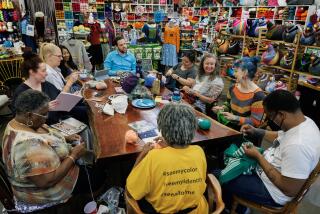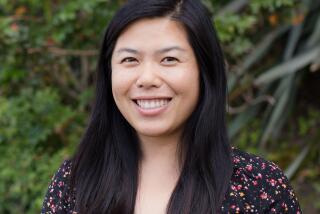Chicken Boy, once and future ruler of the roost
Chicken Boy was lying in the sun behind a Highland Park studio when Amy Inouye reintroduced me to him after a separation of more years than I can remember.
He was in three parts: a stand, his human body and his chicken head, its round, dark eyes staring straight up into the afternoon glare. All 22 feet of his fiberglass body seemed in fine shape for someone who had been in a dissected condition for 23 years.
Once in old L.A., before gang dominance, Disney Hall and $15 martinis, Chicken Boy hovered over Broadway from the roof of a restaurant that, in Inouyeâs words, specialized in garlicky chicken that was deep-fried once and possibly twice.
He was to the downtown area what the Eiffel Tower is to Paris and the Tower of London to Britain. Inouye calls him L.A.âs Statue of Liberty.
Chicken Boy was there when I came to town in 1971 with my simple Oakland ways and soon became symbolic of the peculiar culture that represented my adopted city. He was hokey and odd, but he was ours.
Then one day I was driving up Broadway and sensed an empty space against the smoggy, sepia-colored sky. I suddenly realized that it was because Chicken Boy was gone. Later I learned that new construction had forced him off his perch.
Inouye, who had come to L.A. about the same time from San Mateo to attend the Los Angeles Art Center College of Design, loved âvernacular architecture,â the oversized symbols that designate certain businesses, like a brown derby, a giant doughnut or a mammoth hot dog. Chicken Boy fit into that category.
But over time he came to mean more as she tried to adapt to a new environment. âI was feeling lonesome and homesick wandering through town,â she said, leading me around the building she calls Future Studio that she shares with her live-in, artist Stuart Rapeport. âChicken Boy somehow made me feel Iâd be OK.â
When she discovered that the edifice was coming down, she lobbied to obtain him and was finally offered Chicken Boy as a gift, which she gratefully accepted. Thereafter, she said, showing me clusters of Chicken Boy souvenirs and artifacts, plus an assortment of other stuff that fills her gallery, she tried to place him in various museums, but her offer was refused or ignored. So she took him home.
Now he lies in comfort behind her studio, once an insurance office, awaiting the day when Inouye obtains final city approval to place him atop the roof of her one-story building to forever, or thereabouts, look down on busy little Highland Park and beyond to the foothills of the San Gabriel Mountains.
At one point, he was exhibited in the Arco Plaza Mall where old timers could shed tears of nostalgia and newcomers ponder his existential meaning. A homeless man appeared one day out of nowhere to study the statue and wisely remarked, âWe are all Chicken Boy.â Inouye found in that simple comment philosophical verification of her acceptance as a part of L.A. Iâm not sure why, but that doesnât matter.
In her hands, the fiberglass bird enjoys a good life. He is celebrated in a movie, âChicken Boy: A Chicken With Attitude,â newspaper cartoon panels called âChicken Boy Is Backâ by Rapeport, a Chicken Boy website and catalog, and a lot of dolls, cups, T-shirts, hats and other items that celebrate the mutated form of boy and rooster. Two oil paintings on velvet depict him playing an accordion and a guitar. In the movie he comes to life, endures a series of adventures and becomes an accordion-pumping blues singer.
The studio itself, which Inouye, a book designer, and Rapeport have occupied for three years, deserves mention if only for its vast collection of just about everything, including her fatherâs golf trophy, 17 1950s table lamps, the artwork of a 70-year-old downtown parking attendant named Joe Oliver who discovered an ability to paint when in his 60s, and Rapeportâs scrap wood sculpture of an art critic slumped in a chair, possibly done in by a crazed surrealist.
But the building truly belongs to Chicken Boy. If archeologists dig him up a million years hence, they will no doubt label him Homo gallus gallus and wonder at the figure that celebrated both boy and bird. What tribe? What religion? Sifting through the detritus of time they will finally discover that he was a piece of our history, a shard of the absurd that somehow made sense in the nonsense of L.A.
I guess I find in him a little of what Inouye sees, a gentle reminder that the world isnât all composed of steel and money, but also of dreams and memories and the stuff of fantasy that entwines our brief days on the planet Earth.
I will be there when his statue is hoisted atop the studio in Highland Park and feel my own surge of remembrance of the time in our strange and whimsical City of Angles when Chicken Boy was king.
*
Al Martinezâs column appears Mondays and Fridays. He can be reached at [email protected].
More to Read
The biggest entertainment stories
Get our big stories about Hollywood, film, television, music, arts, culture and more right in your inbox as soon as they publish.
You may occasionally receive promotional content from the Los Angeles Times.










